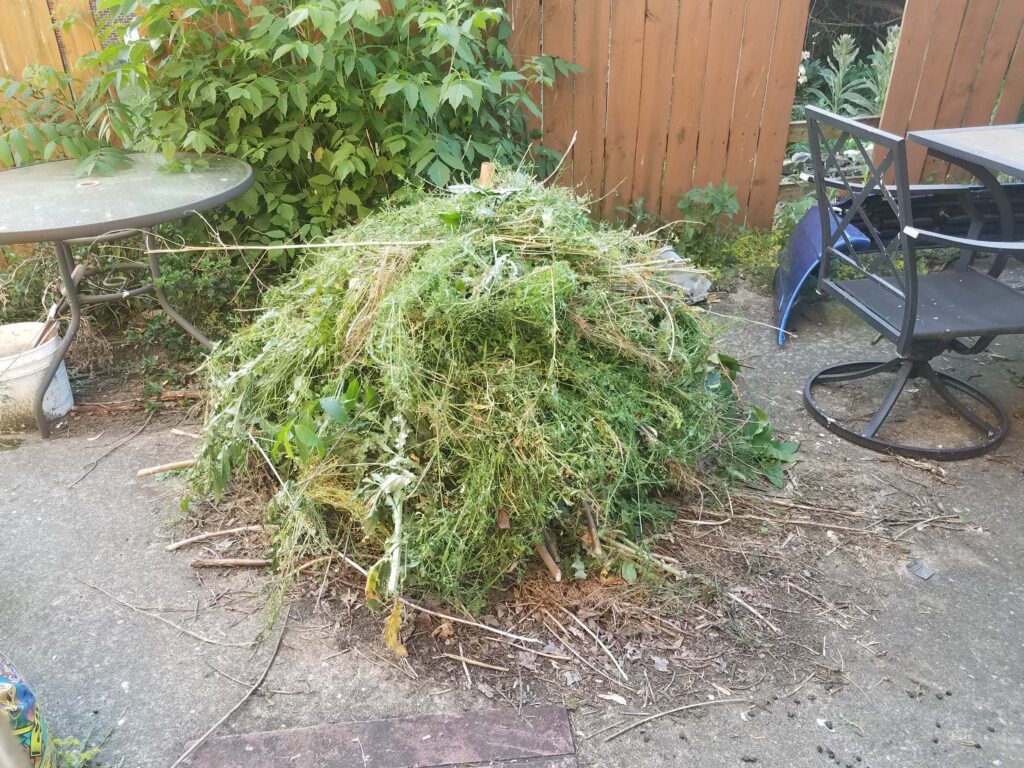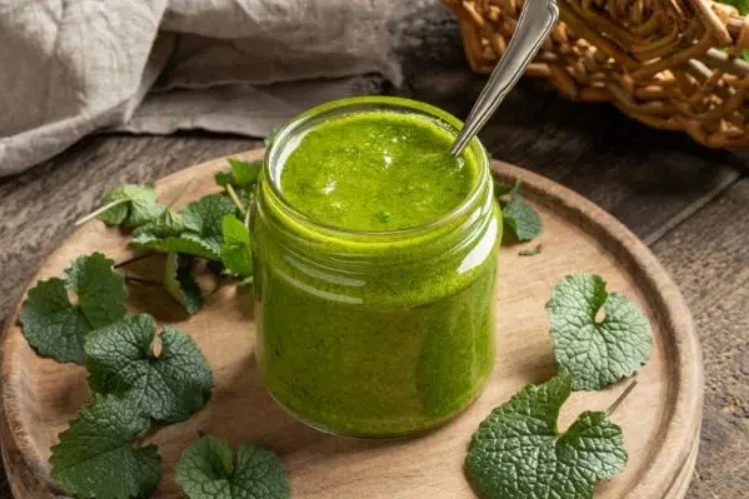Anyone who reads the welcome page of this blog will know that I make no claims to being perfect or being an expert. To quote Brené Brown, “I’m not here to be right; I’m here to get it right.” [1] And that is very much how I try to live my life: I do the best I can with what I know, and then when I know better, I can do better. This weekend brought with it what seemed to be a frustrating, no-win situation for me as a gardener. Fortunately, Christian was around to help with both the physical labor and the emotional labor.
Clearing the Land
I have written recently about difficulties with municipal composting programs, namely that they don’t necessarily compost what you send them – ours doesn’t. To that end, I have had several growing piles of brush in my yard (containing a variety of cleared debris that ranges from handfuls of weeds to tree branches). These piles have built up over the years, slowly deteriorating on the bottom as I add new material to the top, but they were never actually intended to be compost piles – certainly not the one that was living in the middle of our patio. No, they were only ever intended to be temporary locations for yard waste until I could figure out where I could compost them, which I finally did this year. [2]
However – and this is a big however – when I weed, particularly when I am pressed for time (which I always am), I will just pile everything in the closest available spot, meaning that each of these piles almost definitely contains a few representatives of invasive species, including a good bit of our recently discussed friend, Canada thistle. [3] Now, it is important to note that when removing invasive species from your yard (or even natives that you don’t want but that will not give up, such as pokeweed [4]), you should not compost them, particularly any roots, berries, or seeds.

Side note: I am convinced that the mulch I bought last year had wild onion seeds or bulbs in it somewhere, because I had a wild onion explosion in a newly mulched area this spring like nothing I had ever seen before. In short, when it comes to invasive plants, unless you are sending them to the landfill, you are just helping them spread.
Not recognizing some of the invasives in my yard for what they were or knowing how to properly deal with them before doing research on my own, I cannot possibly expect or assume that others are handling them correctly, if at all. (That will not stop me, though, from judging myself for not knowing better from the start!) And one of the things in my yard that I have mishandled for several years now is garlic mustard.
Alliaria petiolata
I had never ever heard of garlic mustard until the first summer of the pandemic. Friends came over to sit in the yard for my birthday, and one of them noted the garlic mustard growing around the pine tree in front of our house. The tall stalks, spade-shaped leaves, and white flowers were something I knew I had seen in our yard and elsewhere before, but I had no idea what they were or that they were invasive. I pulled them if I got to them, which didn’t always happen. If I had started then and remained diligent, we could theoretically be rid of them by now – or close to it.
Garlic mustard is native to Europe and western Asia, and it was brought to North America by settlers as a medicinal plant and/or as a cheap spice. The root has a light horseradish flavor, and the leaves taste, unsurprisingly, like garlic and mustard. The entire plant is edible and nutritious, containing Vitamins A and C and trace minerals, [5] but care needs to be taken when preparing it because the leaves do contain cyanide. Chopping and cooking releases the gas, but make sure you’re following specific instructions if you do plan to cook with it. [6] It has been used in European cuisine for millennia, with its first documented appearance in cookware dating back to about 4000 BC. [7]

Image credit: [8]
The plant is a biennial, meaning that it produces seeds that then grow into plants that produce more seeds and die in their second year. In its first year, garlic mustard grows into a small cluster of leaves that, to me, look like a cross between violets and catnip. In their second year, they bolt (grow stalks), flower, and then grow siliques (seed pods), which burst and spread seeds. Then they’re done. As with other biennial weeds we’ve covered on this blog (most recently bull thistle), if you can get rid of them before they go to seed, you will be all good in a few years (assuming you don’t have seeds introduced by other means).
On the bright side, garlic mustard is easy to identify and even easier to pull. My mom and I had multiple conversations in recent years in which we wondered why it’s such a big deal if it comes out so easily. The problem with it is the level to which it disrupts the lifecycles of native plants and animals. Since it emerges early in the spring, it takes up space and nutrients that natives plants could be using. It also produces a chemical that inhibits the germination of other plants’ seeds nearby. Finally, if insects lay their eggs on the plant, which some do, the hatched larvae will not have food or sufficient nutrition to develop properly, cutting down the population of the next generation. [9]
Dumpster Diving
The other issue is the seeds: every year you miss the opportunity to pull the plants before they go to seed, you extend your eradication timeline for another five years (or more, according to some sources). One healthy plant can produce 800 seeds or more, which burst from the seed pods when ready, so pulling them early in the season is critical. However, and here’s where my laziness / lack of time comes in, just pulling them is not enough. If you leave them out on the ground after pulling them, they will continue their seed-producing journey for as long as they can. Plants don’t die instantly once they’re out of the ground – I have seen thistle and dandelion flowers turn to seed days after the plant itself is pulled, and garlic mustard seed pods were bursting in my weed piles earlier this week.
I knew for several years, since starting to deal with our pokeweed problem, that roots and berries should not be composted. That, actually, is how the patio pile(s) started – so that they wouldn’t return to the earth and continue their lifecycle next to our shed, for example. I still needed to ensure proper disposal once I got around to it. The proper course of action is to bag and trash invasive plants – right away, for reasons mentioned above. However, these piles have become quite sizable over the years, which means that getting everything into our weekly trash was no longer an option.

Image credit: [10]
The plan was to break apart the weed piles as best as possible, maneuver the debris into large yard waste bags, and put them in the once-monthly yard waste dumpster our municipality provides. Again: I have confirmed that the yard waste dumpster actually goes to the landfill – do not go this route if there is any chance the material will be composted. Getting weeds into the yard waste bags and lifting those bags without ripping them was easy enough to manage when the material was dry, which it was after more than a month with no significant rain, but I didn’t get to all of it before days and days of heavy rain rolled in.
Undaunted, Christian and I determined that we could put everything else on a tarp, load it into the trunk of his car, and drive it over to the dumpster. Filling up the tarp with soaked weeds and getting it into the car was bad enough, but then we saw the dumpster. It was huge. The rim was at least seven feet off the ground, and I had barely been able to lift my half of the tarp as high as the car trunk. There was no way I was going to be of any help here, other than chucking the big, dry, yard waste bags into the dumpster, which I did. Meanwhile, Christian found a huge metal garbage can nearby, filled it from the trunk multiple times, and emptied it into the dumpster, trying not to drop the can in the process.
By the time we got home, he was understandably tired, and I was frustrated at how difficult the whole process was. I was also sad to see all of the good compostable material going to the landfill, which it had to after being contaminated with seeds and roots of plants that shouldn’t be allowed to spread. Certainly, I’ll know better for the future: keep invasives separate when weeding and bag them right away so that everything else can go on a compost pile. Ultimately, it does feel good to have the weed piles off the porch – one step closer to making it usable… maybe even this season!
~
Do you have any stories about getting rid of invasives, specifically garlic mustard? Have you cooked with garlic mustard or other weeds? I’d love to hear about it below.
Thanks for reading (and weeding)!
[1] https://brenebrown.com/articles/2020/02/13/the-courage-to-not-know/
[2] https://radicalmoderate.online/composting-yard-waste/
[3] https://radicalmoderate.online/thinning-a-thicket-of-thistle/
[4] https://radicalmoderate.online/bad-fences-make-good-neighbors-catchweed-and-pokeweed/
[5] https://www.phila.gov/2019-03-06-garlic-mustard-an-edible-and-delicious-invasive-plant/
[6] https://www.healthygreensavvy.com/garlic-mustard-recipes-plant/
[7] https://en.wikipedia.org/wiki/Alliaria_petiolata
[9] https://extension.psu.edu/garlic-mustard-a-ubiquitous-invasive-weed
[10] https://www.healthygreensavvy.com/garlic-mustard-recipes-plant/
2 Comments
Jalen · July 2, 2023 at 12:09 pm
I have this growing in my yard but didn’t know what it is, although I just assume most of what’s growing in my yard at this point is invasive. All weeds end up in my compost bin. Ehy is this an issue – do the seeds not break down enough? Does it help that I don’t actually do anything with my compost? It just sits in the bin.
Alison · July 2, 2023 at 3:12 pm
Yeah, typically the issue with backyard composting is that it doesn’t typically get hot enough to destroy the seeds/roots. I believe I heard that commercial composting (which can break down bones) gets hot enough, but I’m not 100% sure.
I can also make no promises for what will happen in your compost bin. It’s a good sign if you don’t have anything sprouting in it, but so many seeds are viable for multiple years, so there’s a risk if/when you do spread it. Presumably you’re going to use it at some point? I’ve still never pulled compost out of my kitchen scrap bin, multiple years into having it…